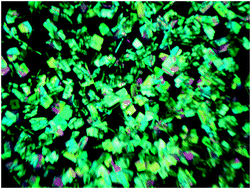Supramolecular gel phase crystallization: orthogonal self-assembly under non-equilibrium conditions
Abstract
This tutorial review charts the history of gel phase crystallization from its origins in Liesegang ring formation to current research in the generation of new pharmaceutical solid forms in low molecular weight organogels. The growth of molecular crystals under a supersaturation gradient within the same space and timescale as the formation of a gel phase material is placed into context as an example of orthogonal self-assembly. Such multi-component, weakly coupled orthogonal self-assembly processes occurring far from equilibrium represent a powerful conceptual paradigm for generating fascinating emergent behaviour in chemical systems.

- This article is part of the themed collection: Nucleation and crystallisation

 Please wait while we load your content...
Please wait while we load your content...